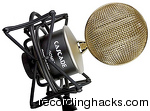
Cascade Gomez Michael Joly Edition – The Tape Op Review
TapeOp Issue #66/July, 2008 | by Andy Hong
The Gomez results from a collaboration between Cascade microphones, headed by CEO Michael Chiriac, and Michael Joly (Tape Op #59) of OktavaMod.
Its single-ribbon motor is enclosed in a single-layer, open-grill headbasket to minimize internal reflections. Due to the short ribbon and wide magnets, the mic’s figure-8 pickup pattern is broad, with very little off-axis coloration, and its frequency response is fairly flat from 20Hz only up to 6kHz, where it begins to fall early, with a 13dB dip near 16kHz. According to Cascade, this voicing is suited for mic’ing guitar amps and vintage-sounding “soft top” vocals.
The build-quality of the mic and the included shockmount is top-notch, and the shiny bits look hand-polished and very bling. Inside is a Lundahl LL2913 ribbon-mic transformer and Evidence Audio’s top-of-the-line Lyric HG wiring. A rubber and foam-lined aluminum suitcase as well as a microfiber cleaning cloth are included. Unfortunately, a mic sock to protect the ribbon while moving the mic isn’t. Each mic comes with a signed letter of inspection/verification and two pages of test results conducted by Cross-Spectrum Labs. The $599 price belies the quality of engineering and construction that’s immediately evident when you open the suitcase and plug in the Gomez, but the Cascade website clearly explains that the low pricing is a result of direct sales without any markups nor commissions for distributors, dealers, advertising agencies, marketing reps, and sales staff.
The Gomez does indeed sound fantastic on guitar amps, especially when positioned 8'' or more from the speaker cone. At this distance, there’s no chuff and no boxiness, nor does the sound get thin, and the backside of the ribbon picks up just enough room to give the guitar track some depth. Closer in, the amp starts to sound bigger than life, as the low end is augmented from proximity effect, but compared to a Royer R-121, there’s less tendency for the amp to sound “scooped” due to both the lows and highs sounding more pronounced than the mids.
The midrange seems to hold its own better with the Gomez, even as its lows get much tubbier at close distances. Further out, where most mics start to sound thin and unfocused, the Gomez still sounds full. There is some loss of “bite” on distorted guitars, but when the Gomez-mic’ed guitar tracks are mixed in with other tracks, that just means there’s more room for the other tracks (like percussive acoustic guitars, snare drum, cymbals, etc.). It also means that the ringing tones characteristic of some amps don’t sound as piercing and icy (which may or may not be your cup of tea). In summary, for guitar amps, the Gomez captures a warm but nicely balanced sound, and with a smooth ramp-up in proximity effect, it’s easy to vary the timbre, especially in the lows and lower mids.
On vocals, I was initially expecting the Gomez to sound too dark, given Cascade’s use of “soft top” in reference to a vintage sound. It indeed sounds dark when positioned 6'' or less from the singer; there’s way too much low-end buildup at close proximity. At 8—12'', vocals open up nicely, and depending on the acoustic treatment in the room, you get a sense of depth and space without the loss of lows and lower mids evident in mics voiced for closer-in work. Because of the early high-end rolloff, there’s no chance of sibilance, and because of the greater working distance, no pesky mouth noises get picked up. Also, at 12'' out, with the mic at forehead level, no pop filter is needed, so wind noise and loss of detail from a filter is a non-issue.
Interestingly, despite the mic’s lack of crispy highs, the quality of articulation and the subtlety in expression the mic captures are startling. Plus, you can boost the highs as much as you want to get back some amount of “air”; even boosting everything from 6kHz on up by 15dB doesn’t bring up any sibilance or sharp edginess.
My favorite use of the Gomez is for room mic. Drums sound incredible with a Gomez positioned at head level, 6ft in front of the kick drum. (When placed on the floor 6ft out, there’s even more oomph to the sound, especially on transients, but placing a ribbon near the floor scares me because the motor will pick up any magnetic crap on the floor.) Two Gomez mics arranged as a Mid-Side pair take this technique to the next level. (Although the Gomez’s headbasket is not front-to-back symmetric, its ribbon motor is; therefore, its figure-8 pickup pattern is symmetric.) Or using one Gomez about 4ft out from the floor tom, pointing at the snare, and one Gomez out in front of the kick and snare so that both mics are equidistant (about 6ft) from both the beater head of the kick and the center of the snare head results in a huge but very natural drum sound.
Adding ambience with the Gomez also works well with piano and acoustic guitar. And believe it or not, tambourine mic’ed with a Gomez at a distance of 3ft sounds good too, and slots easily into a mix with conventionally mic’ed drums and cymbals, without sounding brittle or unnatural as is often the case when close-in condensers are used for handheld instruments in the shaker family.
($599 direct; Cascade Microphones, Michael Joly Editions)
Read more about the Cascade Gomez Michael Joly Edition single-ribbon microphone.
